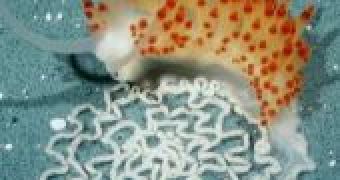A new species of sea slug was discovered in Carpinteria State Park, California, by Jeff Goddard, a project scientists at the Marine Science Institute at UC Santa Barbara.
This new discovery also proves that people should be more careful and more observing of what lives around them, as you never know what you may find, if you look close enough.
Goddard found a new species of nudibranch, a type of sea slugs with delicate forms and very bright colored and as he realized he had made a discovery, he carefully documented it before sending it to further expertize.
He also kept the slug in his lab for a few days until it laid and egg and allowed the scientist to also take a closer look to its early development and hatching larvae.
After this, Goddard sent the specimen to Terrence M. Gosliner, an expert on the classification of sea slugs at the California Academy of Sciences in San Francisco.
The expert named the new California nudibranch species Flabellina goddardi, after the one who discovered it.
Goddard declared himself very flattered and said that it was very exciting that he had discovered this new species, among the “ well known shallow-water nudibranch fauna of Southern California, and right under our noses here in Santa Barbara County.”
This new species of sea slug measures 30mm long when it is stretched out and crawling and as it was the only specimen to be found, “we need to find out where more are hiding, what they feed on, and whom they interact with,” said Goddard.
The Flabellina type also includes the well-known "Spanish shawl" nudibranch, Flabellina iodinea, and the Goddardi is now the fifth species of Californian origins.
In the September 15 online edition of the Proceedings of the California Academy of Sciences, Goslinger wrote that “Flabellina goddardi is named for friend and colleague Jeff Goddard who found the only specimen of this distinctive species.
“Jeff is the consummate naturalist with superb powers of observation,” he added.
This new slug species was discovered in 2008 but as many discoveries of the kind, it often takes several years for gathering documentation, for comparing it with other known species and then publish these findings.

 14 DAY TRIAL //
14 DAY TRIAL //